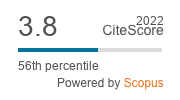TURTLE HEARING CAPABILITY BASED ON ABR SIGNAL ASSESMENT
Abstract
Sea turtles have existed for millions of years. International Union for Conservation of Nature (IUCN) has reported that the Hawksbill Turtle (Eretmochelys imbricata) is classified as critically endangered. Turtle excluder device (TED) deployment on shrimpnet fisheries is needed for turtle conservation.TED using sound technique is challenge method in fisheries development.The knowledge on turtle hearing capability is limited. The auditory brainstem response (ABR) assessment is method to determine turtle hearing capability. Turtle hearing assessment is basis to design TED. The objective of this paper is to determine turtle hearing cability by analyze its ABR spectral.The subject is Hawksbill turtle with number 2 turtles ie: 3 and 2 years. The measurement was taken at Pusat Pengurusan Penyu (Turtle Management Centre) Padang Kemunting Masjid Tanah Melaka Malaysia. The results shows that turtle 3 years have peak power frequencies 50.78, 101.6, 152.3, 304.7, 355.5, 457, and 507.8Hz respectively whereas the spectral amplitude is ranging 0.03-32.44% spectral. Turtle 2 years has peak power at 457Hz in whole stimulus frequencies while the spectral amplitude is ranging 0.01-2.5% spectral.
Full Text:
PDFReferences
. Eckert KL, Bjorndal KL, Abreu-Grobois FA, Donnelly M. Research and Management Techniques for the Conservation of Sea Turtles. Marine Turtle Newsletter. 2000; 87: 17.
. Putrawidjaja, M. Marine Turtles in Irian Jaya - Indonesia, Marine Turtle Newsletter. 2000; 90: 8-10.
. Yudhana A, Din J, Abdullah S, Sunardi. An Identification of Turtle Hearing Threshold for Design TED (Turtle Excluder Device) Using Sound Technology. International Conference on Information and Communication Technology & Systems (ICTS). Surabaya. 2008.
. Elvir AJ, Causevic E, John R, Koyacevix J. Adaptive Complex Wavelet-Based Filtering of EEG for Extraction of Evoked Potential Responses. ICASSP IEEE. 2005; 5: 393-396.
. Kuwada S, Anderson JS, Batra R, Fitzpatrick DC, Teissier N, D’Angelo WR. Sources of The Scalp-Recorded Amplitude Modulated Following Response. J Am Acad Aud. 2002; 13: 188-204
. User Manual. Intelligent Hearing Systems. 2007
. Hecox K, Galambos R. Brainstem Auditory Evoked Response in Human Infants and Adults. Arch Oto. 1974; 99:30-33.
. Davey R, McCullagh P, Lightbody G, McAllister G. Auditory Brainstem Response Classification: A hybrid Model Using Time and Frequency Features. Artificial Intelligence in Medicine. 2007; 40(6): 1-14
. Mooney TA, Tachtigall PE, Yuen ML. Temporal resolution of the Risso’s Dolphin, Grampus Griseus, Auditory system. J. Comp Physiol. 2006
. Popper. http://www.life.umd.edu/biology/popperlab/research/americanshad.htm. Ultrasonic. 2000.
. Ketten DR, Bartol SM. Functional Measures of Sea Turtle Hearing. Final rept. Woods Hole Oceanographic Inst Ma Biology Dept. 2006.
. Lovell JM, Findlaya MM, Moateb RM, Yan HY. The hearing abilities of the prawn Palaemon serratus. Comparative Biochemistry and Physiology. 2005; A(140): 89-100.
. Howorth P. Underwater Sound Measurements. http://channelislands.noaa.gov/sac/pdf/ acoustic.pdf. 2003: 1-3.
DOI: http://doi.org/10.12928/telkomnika.v8i2.620
Refbacks
- There are currently no refbacks.

This work is licensed under a Creative Commons Attribution-ShareAlike 4.0 International License.
TELKOMNIKA Telecommunication, Computing, Electronics and Control
ISSN: 1693-6930, e-ISSN: 2302-9293
Universitas Ahmad Dahlan, 4th Campus
Jl. Ringroad Selatan, Kragilan, Tamanan, Banguntapan, Bantul, Yogyakarta, Indonesia 55191
Phone: +62 (274) 563515, 511830, 379418, 371120
Fax: +62 274 564604

